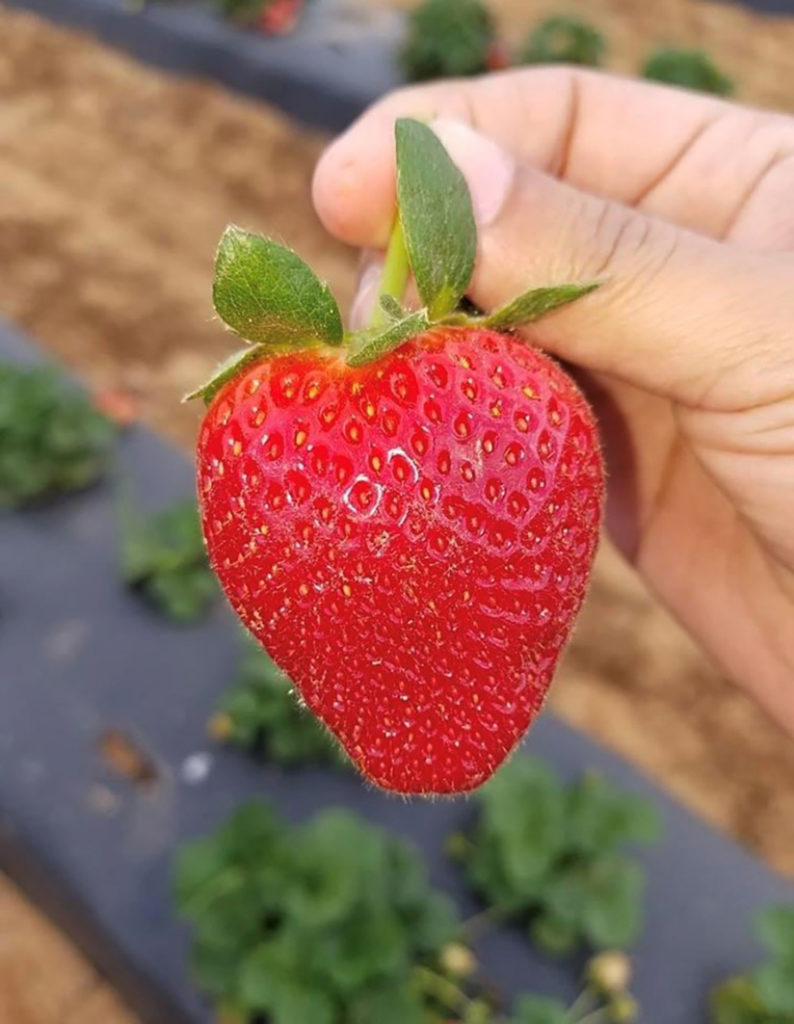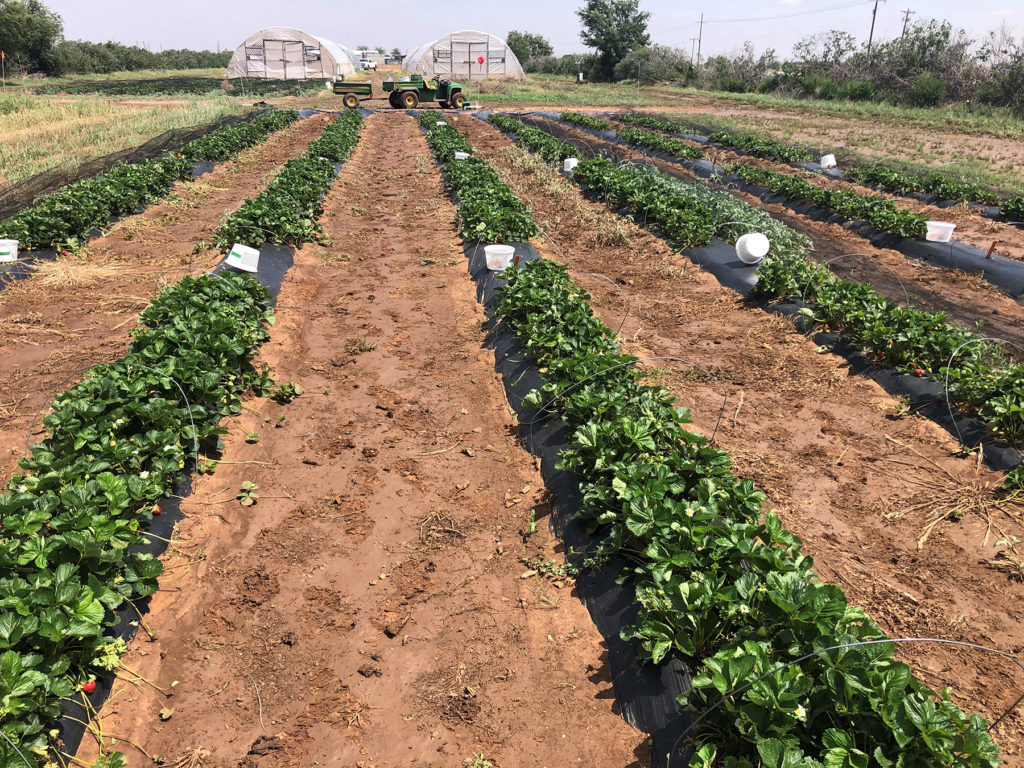Getting the most from your strawberry plants
Texas A&M AgriLife team researches best management practices for growers
Strawberries are a high-input but high-value crop, and local growers can sell everything they grow at very good prices. However, grower management practices can make a difference in the bottom line.

To ensure growers can provide best management, a project led by the Texas A&M AgriLife Extension Service is in its second year of evaluating various managing practices. These include planting dates, use of shade cloth to extend the season and reduce plant heat stress, fertilizer rates, irrigation levels for nitrogen leaching in soil, plant spacing and herbicides for weed control.
“Consumers want locally grown strawberries,” said Russ Wallace, Ph.D., an AgriLife Extension horticulturist in Lubbock and professor in Texas A&M’s Department of Horticultural Sciences. “However, growers should learn optimal strawberry production methods before spending their money.”
Wallace leads the research project to conduct collaborative statewide trials at the Texas A&M AgriLife Research and Extension Center at Lubbock, Prairie View A&M University and a grower’s farm in Atascosa County.
The project is funded by a grant sponsored from a 2020 Texas Department of Agriculture Specialty Crops Block Grant Program.
Poteet, in Atascosa County, has the highest concentration of strawberry growers in Texas, and the Poteet Strawberry Growers Association and the Poteet Rotary Club helped purchase plants for the trials each year.
“Our main goal is to provide research-backed information and training for those wanting to grow strawberries on the High Plains, as well as throughout the state,” Wallace said. “We encourage growers to discuss potential strawberry production with experts at AgriLife Extension prior to growing berries.”

Other members of the team include Thayne Montague, Ph.D., associate professor, who is jointly appointed to Texas A&M AgriLife Research and the Texas Tech University Department of Plant and Soil Sciences; Peter Ampim, Ph.D., research scientist, Prairie View A&M University, Prairie View; Larry Stein, Ph.D., associate department head and AgriLife Extension leader for the Department of Horticulture Sciences, Uvalde; Dale Rankin, AgriLife Extension agent, Atascosa County; Laura Miller, AgriLife Extension horticulture agent, Tarrant County; and Janet Laminack, AgriLife Extension horticulture agent, Denton County.
Wallace said all trials are being repeated this growing season. More information about the trials and results will be shared at the Strawberry Field Day at 6 p.m. May 4 at the Texas A&M AgriLife Research and Extension Center for Lubbock, 1102 E. Drew St.
Those who would like to attend should RSVP to Dena Graves at [email protected] by April 29.
Strawberry trial results
Wallace said the team is in its second year of research, and the project will be finished by August.
“We currently have six trials, including evaluations of planting dates, using shade cloth to extend the season and reduce plant heat stress, evaluations of varieties across four fertilizer rates, evaluating irrigation levels for nitrogen leaching in soil, plant spacing, and evaluating herbicides for weed control,” he said.
Planting dates
In Texas, strawberries should be planted in the fall as soon as plants arrive in early to mid-October, Wallace said. However, sometimes due to unforeseen circumstances, growers may not be ready to plant at that time. Therefore, planting may be delayed for up to four weeks.
To investigate the effects of different planting dates, the team is evaluating four varieties — Albion, Camino Real, Fronteras and Merced — on their yield potential when planted during mid-October and then at two-week intervals through mid-November. Previous experience has shown planting later than mid-November may result in no yields the following spring.
“Our results indicate that delaying planting by two or four weeks can significantly reduce yields in the spring,” Wallace said. “The varieties evaluated in Lubbock lost an average 1.7% berry yield per day if planted as late as mid-November. This may not sound like much, but when evaluated economically, delaying planting up to four weeks could reduce profits by $550 per acre per day. Growers should have fields ready to plant as soon as their crop arrives.”
Shade
Strawberries are a cool-season crop. They are fall-planted to allow colder temperatures to increase bud and crown formation to enhance flowering and berry production in the spring, Montague said. Excessive heat during May through July can reduce flowering.

Trials were evaluated at Poteet and Lubbock with two levels of shade cloth — 30% and 50% shade plus a full sun treatment. Plants were covered with the shade cloth treatments for the entire season from November to June, or only in the spring from April through June.
Montague said their first year of trials generally showed covering strawberries with shade cloth reduced air and soil temperatures.
“Our early shaded yields were lower initially compared to those in the full sun,” he said. “However, by the final harvest, strawberries covered with 50% shade cloth had a longer harvest season, improved berry quality and higher yields. While shade cloth improved berry yields, we know shade cloth may be expensive. However, shade cloth may be used for multiple seasons if properly cared for.”
Fertilization rate comparison by variety
Strawberries, in general, are heavy feeders of nitrogen and require certain micronutrients for optimal growth. Strawberries grow best on soils with a pH below 7, Wallace said.
“However, on the High Plains, our soil pH is often much higher,” he said. “We’ve been successful by adding high-acid fertilizer formulations to our strawberry beds, which reduce soil pH during the crop season.”
He said they generally recommend about 1 pound of nitrogen per acre per day during the season. But in the trials, the team is evaluating four different rates of nitrogen plus micronutrients — 0 pounds per acre up to 120 pounds of nitrogen per acre — on four strawberry varieties.
“Our results indicate the yield of one variety decreased with higher nitrogen rates, while two varieties increased yields, and one variety had no response,” Wallace said. “These results indicate it would be wise for strawberry growers to fertilize varieties according to their needs and not just fertilize all varieties equally. We hope to evaluate more varieties in the future.”
Irrigation and plant spacing
In the past, Wallace said they had supposed strawberries required high amounts of water. Strawberries are irrigated using surface drip placed just below the plastic mulch on which they are grown. The plastic mulch increases soil temperatures to improve crop growth, reduces weed pressure and, perhaps more importantly, reduces soil water evaporation.
With concerns for reduced groundwater availability, he said they evaluated four levels — 100%, 80%, 60% and 40% — of irrigation on strawberries planted at three different spacings.
“While plant spacing was not a factor, we did observe plants grew larger and had 32% higher yields at the 40% and 60% irrigation levels compared to the 100% treatment,” Wallace said. “From our soil analyses, we observed total nitrogen levels in the soil were 16% higher at the two lower levels compared to the 100% treatment.”
He said these results indicate while strawberries require a high amount of nitrogen, using higher irrigation rates potentially leaches nitrogen from the soil, thereby decreasing plant growth and yield.
Weed control
Strawberry growers on the High Plains, in Atascosa County and elsewhere across the state have relied on costly hand weeding for decades. In fact, Wallace said, few growers use herbicides in their strawberry fields. Hand-weeding costs can be as high as $1,500 per acre for the season.
“We evaluated several herbicides and observed pre-emergent applications of Spartan 4F (sulfentrazone) can provide control of weeds for three to four months after planting,” he said. “Excellent grass control is also achieved with postemergence applications of Select Max (clethodim). These two herbicides can significantly reduce weed populations and decrease the time and money growers and employees spend hand weeding fields.”





